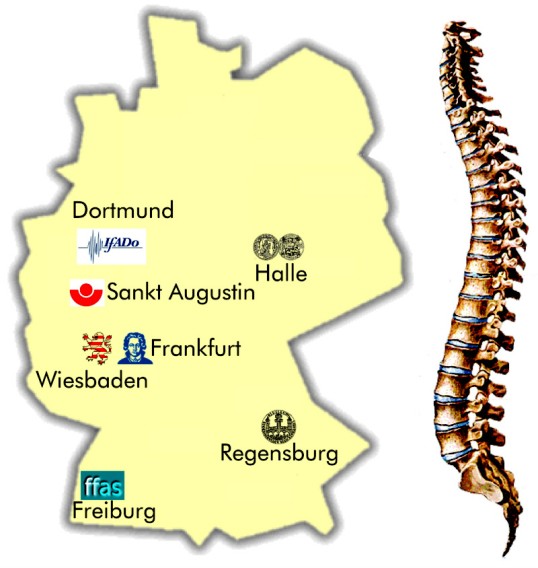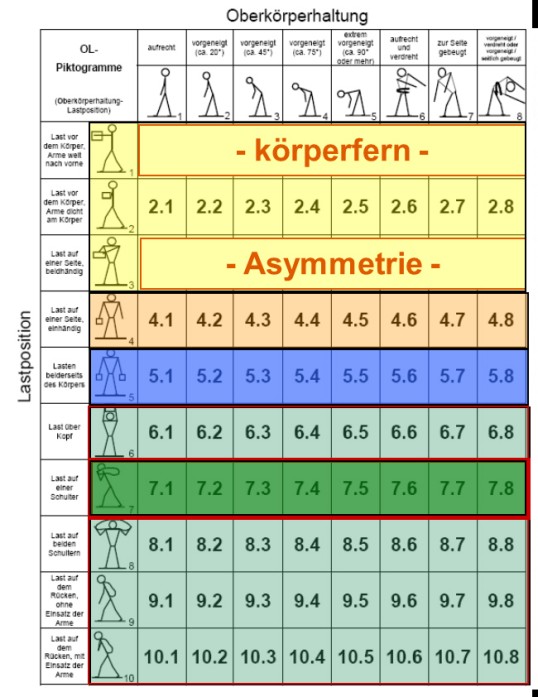- Artificial Intelligence (AI)
- Occupational exposure limit values
- Climate Change and Occupational Safety
- List of CMR substances
- Electromagnetic fields
- Ergonomics
- Industrial Security
- Collaborative robots
- Noise
- Nanoparticles at the workplace
- Optische Strahlung
- REACH
- Reference materials
- Proficiency testing
- Vibration
- Virtual reality
- Work 4.0
The German Spine Study (DWS)
Part I (DWS I)
Together with a number of other scientific institutions, the institute under its former name BGIA participated in an epidemiological study launched by the DGUV into the relationships between occupational (spinal) loading and the incidence of injury to the intervertebral discs, in order to permit realistic assessment of occupational spinal loading in the context of investigations into suspected cases of formally recognized occupational disease (BK No. 2108).
Results
The study was completed in March 2007 with submission of the first version of the final report to the initiator of the study. In the same month, the results were presented for the first time to an interested expert audience at the 47th annual conference of the DGAUM (Deutsche Gesellschaft für Arbeitsmedizin und Umweltmedizin) in Mainz. The results of the study have been published comprehensively in the Zentralblatt für Arbeitsmedizin, Arbeitsschutz und Ergonomie:
Zentralblatt für Arbeitsmedizin, Arbeitsschutz und Ergonomie
The German Spine Study (Die Deutsche Wirbelsäulenstudie), Part 1 (PDF, 1.1 MB, non-accessible) : 9 (2007) Vol. 57
(in German, summaries in English)
-
Kranig, A.:
Basics and targets of the German Spine Study, p. 242 -
Linhardt, O.; Bolm-Audorff, U.; Bergmann, A.; Ditchen, D.; Ellegast, R.; Elsner, G.; Haerting, J.; Hofmann, F.;
Jäger, M.; Luttmann, A.; Michaelis, M.; Petereit-Haack, G.; Seidler, A.; Grifka, J.:
Study design of the German Spine Study, pp. 243-250 -
Ellegast, R.; Ditchen, D.; Bergmann, A.; Bolm-Audorff, U.; Elsner, G.; Grifka, J.; Haerting, J.; Hofmann, F.;
Jäger, M.; Linhardt, O.; Luttmann, A.;. Michaelis, M.; Petereit-Haack, G.; Seidler, A.:
Survey on work-related spinal exposures by technical experts of the German accident insurance institutions within the German Spine Study, pp. 251-263 -
Jäger, M.; Geiß, O.; Bergmann, A.; Bolm-Audorff, U.; Ditchen, D., Ellegast, R.; Elsner, G.; Grifka, J.; Haerting, J.; Hofmann, F.; Linhardt, O.; Michaelis, M.; Petereit-Haack, G.; Seidler, A.; Luttmann, A.:
Biomechanical analyses on lumbar load within the German Spine Study, pp. 264-276 -
Michaelis, M.; Hofmann, F.; Bolm-Audorff, U.; Bergmann, A.; Ditchen, D.; Ellegast, R.; Elsner, G.; Grifka, J.;
Haerting, J.; Jäger, M.; Linhardt, O.; Luttmann, A.; Nübling, M.; Petereit-Haack, G.; Seidler, A.:
Economic sectors and occupations at risk for the development of lumbar spine diseases – Results of the German Spine Study, pp. 277-286
Zentralblatt für Arbeitsmedizin, Arbeitsschutz und Ergonomie
The German Spine Study (Die Deutsche Wirbelsäulenstudie), Part 2 (PDF, 796 kB, non-accessible) : 10 (2007) Vol. 57
(in German, summaries in English)
-
Seidler, A.; Bergmann, A.; Ditchen, D.; Ellegast, R.; Elsner, G.; Grifka, J.; Haerting, J.; Hofmann, F.; Jäger, M.; Linhardt, O.; Luttmann, A.; Michaelis, M.; Petereit-Haack, G.; Bolm-Audorff, U.:
Relationship between the cumulative spinal load due to materials handling and lumbar disc herniation – Results of the German Spine Study, pp. 290-303 -
Bolm-Audorff, U.; Bergmann, A.; Ditchen, D.; Ellegast, R.; Elsner, G.; Grifka, J.; Haerting, J.; Hofmann, F.;
Jäger, M.; Linhardt, O.; Luttmann, A.; Michaelis, M.; Petereit-Haack, G.; Seidler, A.:
Relationship between manual materials handling and lumbar chondrosis – Results of the German Spine Study, pp. 304-316 -
Bergmann, A.; Seidler, A.; Schumann, B.; Fischer, S.; Bolm-Audorff, U.; Ditchen, D.; Ellegast, R.; Elsner, G.;
Grifka, J.; Hinz, B.; Hofmann, F.; Jäger, M.; Linhardt, O.; Luttmann, A.; Michaelis, M.; Petereit-Haack, G.; Haerting, J.:
Association between occupational exposure to whole-body vibration and disc-related diseases of the lumbar spine – Evaluations within the German Spine Study, pp. 317-327 -
Petereit-Haack, G.; Bolm-Audorff, U.; Ditchen, D.; Ellegast, R.; Elsner, G.; Grifka, J.; Haerting, J.; Hofmann, F.;
Jäger, M.; Linhardt, O.; Luttmann, A.; Michaelis, M.; Schumann, B.; Seidler, A.:
Association between occupational psychosocial strain and disc diseases of the lumbar spine – Results of the German Spine Study, pp. 328-336
The German Spine Guideline Values Study (DWS II)
The published results of the German Spine Study (Deutsche Wirbelsäulenstudie) suggest that cumulative dose models simulate the risks of discogenic diseases of the lumbar spine more effectively than does the "Mainz-Dortmunder" Dose model (MDD). The cumulative dose models can be characterized by reduced guideline values (thresholds) for the daily dose and (at the same time) for the compressive force and (at the same time) for the forward inclination of the trunk, and by the inclusion of modes of load manipulation such as pulling and pushing. The results of the German Spine Study are now to be interpreted with greater differentiation by variation of the parameters stated (daily dose, compressive force, trunk inclination, mode of load handling) separately from each other, in order to permit scientific discussion of the legal definition of occupational disease No 2108 in accordance with the German ordinance on occupational diseases (BKV) and derivation of suitable guideline values (DWS guideline value study - DWS II).
A further objective of this reanalysis was to achieve a reasonable reduction in the extensive survey instrument used by the technical inspectorates and described in the German Spine Study and to adapt it, as with the MDD, to the demands of a method suitable for use in the field. The IFA's tasks included the provision of compressive force values and of formulae for estimation of the compressive forces for the stresses on the survey form used by the technical inspectorates. These formulae were then to be reduced in number by appropriate merging; the extent to which the daily dose values calculated by means of these formulae correspond to the equivalent values obtained by biomechanical simulation was to be checked at every stage.
As result of these efforts, a method has been produced comprising the following elements for estimation of the intervertebral disc compressive forces:
- Tabular values (e.g. for eight trunk postures, shovelling processes, specific tasks in nursing and geriatric care)
- A set of formulae (for lifting, holding, carrying of loads in various forms)
- Modulating factors for the consideration of load manipulation performed away from the body, asymmetrically and with one hand
A progressive reduction of the number of formulae with review of the validity after each step ultimately yielded a set of eleven formulae representing a reasonable compromise between precision and ease of application. The instrument developed here may be regarded as an essential basis for a method suitable for use in the field for determining exposure during future procedures for the investigation of cases of occupational disease BK 2108.
The results of the extended evaluation of DWS II have been published in the Zentralblatt für Arbeitsmedizin, Arbeitsschutz und Ergonomie:
Zentralblatt für Arbeitsmedizin, Arbeitsschutz und Ergonomie
EPILIFT Exposure Criteria Study. Vol 64, 2014
(in German, summaries in English)
-
Jäger, M.; Jordan, C.; Voß, J.; Bergmann, A.; Bolm-Audorff, U..; Ditchen, D.; Ellegast, R.; Haerting, J.; Haufe, E.; Kuß, O.; Morfeld, P.; Schäfer, K.; Seidler, A.; Luttmann, A.:
Extended Evaluation of the German Spine Study. Background and methodology of the EPILIFT Exposure Criteria Study (PDF, 1.3 MB, non-accessible) . No. 3, pp. 151-168 -
Morfeld, P.; Ellegast, R.; Ditchen, D.; Kuß, O.; Schäfer, K.; Kersten, N.; Haufe, E.; Luttmann, A.; Jäger, M.:
Estimation of cumulative dose models to analyse effects of physical exposure. Methodology of Multimodel Analysis within the EPILIFT Exposure Criteria Study (PDF, 1.7 MB, non-accessible) . No. 3, pp. 169-182 -
Bergmann, A.; Bolm-Audorff, U.; Ditchen, D.; Ellegast, R.; Haerting, J.; Kersten, N.; Luttmann, A.; Morfeld, P.; Schäfer, K.; Skölziger, R.; Jäger, M.; Seidler, A.; Kuß, O.:
Lumbar disc herniation with radicular syndrome and advanced osteochondrosis. Prevalence estimation for the general population within the EPILIFT Exposure Criteria Study (PDF, 239 kB, non-accessible) . No. 4, pp. 233-238 -
Seidler, A.; Bergmann, A.; Bolm-Audorff, U.; Ditchen, D.; Ellegast, R.; Euler, U.; Haerting, J.; Haufe, E.; Jordan, C.; Kersten, N.; Kuß, O.; Luttmann, A.; Morfeld, P.; Schäfer, K.; Jäger, M.:
Dose-response relationship between physical exposure and Iumbar spine disease. Results of the EPILIFT Exposure Criteria Study (PDF, 2.7 MB, non-accessible) . No. 4, pp. 239-257 -
Ditchen, D.; Lundershausen, N.; Bergmann, A.; Bolm-Audorff, U.; Haerting, J.; Haufe, E.; Kersten, N.; Luttmann, A.; Morfeld, P.; Schäfer, K.; Seidler, A.; Voß, J.; Jäger, M.; Ellegast, R.:
Assessment of lumbar-disc compressive forces in German occupational disease no. 2108. Development of an instrument within the EPILIFT Exposure Criteria Study (PDF, 1.4 MB, non-accessible) . No. 4, pp. 258-269
The German Spine Study (DWS I)

Annex (PDF, 3.3 MB, non-accessible)
First review of the results by DGUV (PDF, 53 kB, non-accessible)
Zentralblatt für Arbeitsmedizin, Arbeitsschutz und Ergonomie 57 (2007) No 9 and 10 (in German, summaries in English):
DWS Guideline Values Study
(DWS II)

- Final report (PDF, 4.3 MB, non-accessible) (in German)
- Study results and evaluation (PDF, 21,5 MB) (in German)
Zentralblatt für Arbeitsmedizin, Arbeitsschutz und Ergonomie 64 (2014) No. 3 and No. 4 (in German, summaries in English):
- Jäger, M. et al.: Extended Evaluation of the German Spine Study. Background and methodology of the EPILIFT Exposure Criteria Study (PDF, 1.3 MB, non-accessible)
- Morfeld, P. et al.: Estimation of cumulative dose models to analyse effects of physical exposure. Methodology of Multimodel Analysis within the EPILIFT Exposure Criteria Study (PDF, 1.7 MB, non-accessible)
- Bergmann, A. et al.: Lumbar disc herniation with radicular syndrome and advanced osteochondrosis. Prevalence estimation for the general population within the EPILIFT Exposure Criteria Study (PDF, 239 kB, non-accessible)
- Seidler, A. et al.: Dose-response relationship between physical exposure and Iumbar spine disease. Results of the EPILIFT Exposure Criteria Study (PDF, 2.7 MB, non-accessible)
- Ditchen, D. et al.: Assessment of lumbar-disc compressive forces in German occupational disease no. 2108. Development of an instrument within the EPILIFT Exposure Criteria Study. (PDF, 1.4 MB, non-accessible)
Information on the project
FF-FB0155A
Projektpartner

Leibniz Research Centre for Working Environment and Human Factors at TU Dortmund University
German Social Accident Insurance Institution for the trade and distribution industry (BGHW), Mannheim
Darmstadt regional authority, occupational safety and health and environment department, regional industrial medical officer's unit, Wiesbaden
Federal institute for occupational safety and health (BAuA), Berlin
Institute of medical epidemiology, biometrics and information science, Martin Luther University, Halle-Wittenberg
Institute and Polyclinic of Occupational and Social Medicine, Carl Gustav Carus medical faculty of Dresden Technical University
Institute for Occupational Epidemiology and Risk Assessment (IERA) of Evonik Industries AG, Essen

